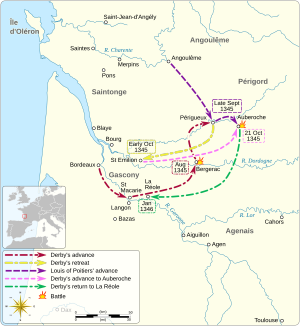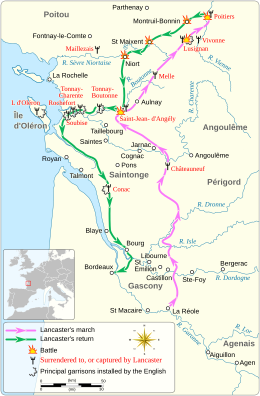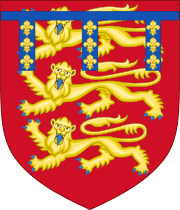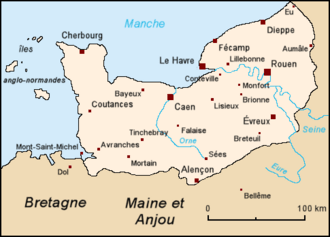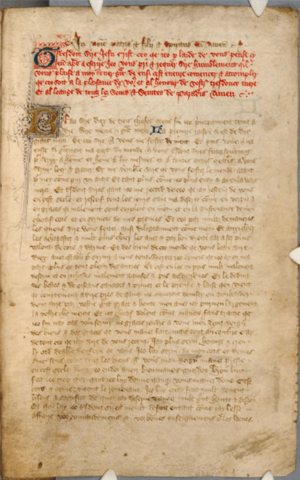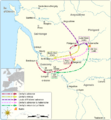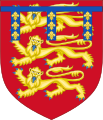Henry of Grosmont, Duke of Lancaster facts for kids
Henry of Grosmont, Duke of Lancaster (born around 1310 – died 23 March 1361), was an important English leader. He was a skilled politician, a diplomat who helped make peace, a brave soldier, and even a writer. Henry owned Bolingbroke Castle and was part of the powerful House of Plantagenet, the royal family of England at the time. He was one of the richest and most influential nobles in the country.
Henry was the son of Henry, 3rd Earl of Lancaster. King Edward III trusted him greatly, especially during the early years of the Hundred Years' War. Henry of Grosmont became famous for his victory at the Battle of Auberoche. In 1348, he was one of the first members of the special Order of the Garter, a group of elite knights. In 1351, he was given the very important title of Duke of Lancaster. Henry was also a thoughtful person who taught himself to write. He wrote a book called Livre de seyntz medicines, which was about his religious beliefs. He is also remembered for helping to start Corpus Christi College, Cambridge, a famous university college, in 1352.
Quick facts for kids
Henry of Grosmont
|
|
|---|---|
| Duke of Lancaster Earl of Lancaster and Leicester |
|
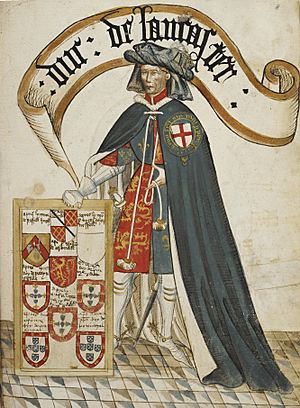
Duc de Lancaster, from the Bruges Garter Book (1430) by William Bruges
|
|
| Born | c. 1310 Grosmont Castle, Grosmont, Monmouthshire, Wales |
| Died | 23 March 1361 (aged 50–51) Leicester Castle, Leicester, Leicestershire, England |
| Buried | 14 April 1361 Church of the Annunciation of Our Lady of the Newarke |
| Wars and battles | |
| Noble family | Plantagenet |
| Spouse(s) | Isabel of Beaumont |
| Issue | |
| Father | Henry, 3rd Earl of Lancaster |
| Mother | Maud Chaworth |
Contents
Early Life and Family Connections
Henry of Grosmont was the only son of Henry, 3rd Earl of Lancaster. His grandfather, Edmund Crouchback, was the second son of King Henry III. This made Henry of Grosmont a second cousin to King Edward III. His mother was Maud Chaworth.
We don't know much about Henry's childhood. He was probably born around 1310 at Grosmont Castle in Grosmont, Wales. Henry later wrote that he was a "good looking, youth. Tall fair and slim". He was better at sports and fighting than at school. He actually learned to read later in life.
Henry was set to inherit a lot of wealth from his uncle, Thomas, 2nd Earl of Lancaster. Thomas was the richest noble in England. However, Thomas had many arguments with King Edward II and was executed in 1322. Since Thomas had no children, his wealth and titles went to Henry's father.
In 1327, Henry's father helped remove King Edward II from power. When Edward III became king in 1330, things got better for the family. Henry of Grosmont was knighted the same year. He often represented his father in Parliament and helped manage the family's lands. In 1331, he even took part in a royal tournament in London.
Becoming a Powerful Noble
Henry of Grosmont was expected to inherit most of the Lancaster family's wealth. In 1337, King Edward III gave him the title of Earldom of Derby. This was one of his father's lesser titles. The King also gave Henry money and lands as a reward for his service. This showed that Henry's future with the King was secure.
In the early 1340s, Henry helped the King by arranging loans from bankers. This sometimes caused him financial problems, and he was even imprisoned a few times because of the King's debts. He helped pay to get the King's crown back when it was pawned.
Fighting in Scotland
In 1328, England and Scotland signed a peace treaty, but many English people didn't like it. Some Scottish nobles who had lost their lands joined forces with Edward Balliol, who wanted to be King of Scotland. King Edward III secretly supported them.
In 1332, Balliol's forces invaded Scotland and won a big battle. Balliol was crowned king, but most Scots didn't accept him. He soon fled to England and asked Edward III for help.
In 1333, Henry of Grosmont joined King Edward III's large army to besiege the Scottish town of Berwick-upon-Tweed. The Scots tried to help Berwick, but they were crushed by the English at the Battle of Halidon Hill. Henry was likely part of this battle. Berwick surrendered the next day.
Henry continued to fight in Scotland with Edward III's army. In 1336, he led 500 knights and 1,000 archers to Perth. He rescued a noblewoman who was trapped in Lochindorb Castle. He also led a long raid to Aberdeen, burning the town and destroying the countryside. These experiences helped him become a skilled military leader.
Campaigns in France
Early Battles in Northeast France
Henry's first trip abroad was to Brabant in 1332. Six years later, he went with Edward III to Flanders. The King had trouble paying his allies to fight the French. Henry was even held as a promise for the King's debts.
In 1339, Henry led part of Edward III's army into France. They besieged Cambrai and destroyed the area around it. The French avoided a direct battle.
In June 1340, Henry was at the great English victory in the naval Battle of Sluys. The English fleet attacked the French and destroyed most of their ships. French losses were huge. After this, Henry was again held as a hostage in the Low Countries because the King owed a lot of money. He was released after promising to pay a large ransom.
Victories in Southwest France (1345)
In 1345, Edward III decided to attack France from three different directions. Henry of Grosmont was put in charge of the forces in Gascony, in southwest France. He arrived in Bordeaux with 500 knights and 1,500 English and Welsh archers.
Instead of fighting defensively, Henry decided to attack the French directly. He quickly moved to Bergerac and surprised the French army on 26 August, winning a major victory in the Battle of Bergerac. Many French soldiers were killed or captured. Henry gained a huge amount of money from ransoms and loot.
Henry then moved north to Périgueux. A large French army, led by John, Duke of Normandy, gathered in the area. In October, a French force of 7,000 men besieged the castle of Auberoche. Henry, with only 1,200 English and Gascon soldiers, marched quickly to help.
On 21 October, Henry attacked the French camp at Auberoche while they were eating dinner. He completely surprised them. After a tough fight, the small English force inside the castle also attacked the French from behind. The French army broke and fled. Many French nobles were captured, bringing even more wealth to Henry and his soldiers.
Historians call Henry's campaign in 1345 "the first successful land campaign" of the Hundred Years' War. His leadership was praised as "superb and innovative" and "brilliant."
The Siege of Aiguillon (1346)
In 1346, Duke John of Normandy led a huge French army, much larger than Henry's forces, to besiege the town of Aiguillon on 1 April. The town was very important because it controlled two rivers. Henry, now known as Lancaster after his father's death, sent an urgent message to King Edward for help.
The small group of 900 defenders in Aiguillon kept attacking the French. Lancaster kept his main army nearby as a threat. Duke John could never fully surround the town, and his own supply lines were often attacked. Lancaster even managed to get a large supply train into the town.
In July, the main English army landed in northern France and marched towards Paris. King Philip VI of France repeatedly ordered his son, Duke John, to leave the siege and bring his army north. But Duke John refused, seeing it as a matter of honor. By August, the French army was running out of supplies, and many soldiers were getting sick or leaving. On 20 August, the French finally gave up the siege and marched away.
Six days later, the main French army was badly defeated at the Battle of Crécy, before Duke John's army could join them. The English then began the siege of Calais.
While the French were distracted, Lancaster launched new attacks in southwest France. He led a long raid, capturing many towns and castles, and even storming the rich city of Poitiers. These attacks completely messed up the French defenses in the region.
Becoming Duke of Lancaster
In 1345, while Henry was fighting in France, his father died. Henry became the Earl of Lancaster, making him the wealthiest and most powerful noble in England. He also inherited Bolingbroke Castle.
After helping in the Siege of Calais in 1347, King Edward III honored Lancaster by making him one of the first members of the Order of the Garter in 1348. In 1351, Edward gave Lancaster an even greater honor: he made him Duke of Lancaster. This was a very new and important title in England.
The King also gave Lancaster special powers over the county of Lancashire. This meant Henry could govern Lancashire almost like an independent ruler, separate from the Crown. This was a very rare and special privilege. It showed how much Edward III respected and trusted Henry. The King and Henry were cousins and close in age, so they had a strong friendship.
In 1350, Henry of Grosmont was at the English naval victory at the Battle of Winchelsea. He even commanded his own ship, along with the King and the King's sons.
Around 1351, Henry went on a crusade to Prussia. While there, he decided to join the Teutonic knights. However, he was captured and had to pay a large ransom to be released. He later had a disagreement with another duke, which almost led to a duel in Paris. The French king had to step in to stop it.
Campaigns in Normandy (1356)
After some years of diplomatic work, full-scale war between England and France started again in 1355. In 1356, King John of France arrested several important nobles in Normandy. These nobles then asked King Edward III for help.
Edward sent Henry of Grosmont to Normandy to support the French rebels. On 1 June 1356, Henry arrived with his forces. He was joined by other English and Norman soldiers, bringing his army to about 4,000 men.
The Normandy Raid
Henry's main goal was to help the Navarrese strongholds (castles) that were under siege by the French. On 24 June, Henry's army began a "chevauchée" (a large-scale mounted raid) into French-controlled Normandy. They moved quickly, looting and burning villages and weak towns. Stronger places were avoided.
Henry's army reached Pont-Audemer, which was close to falling to the French. The French fled when they heard Henry was coming. Henry then marched south, capturing and burning Conches-en-Ouche. The next day, he reached Breteuil, which was also under siege, and resupplied it.
Henry then moved to Verneuil, a rich town, which he captured and looted. The strongest men in the district had hidden in Verneuil's strong tower with their valuables. Henry's forces attacked the tower, and its defenders eventually surrendered, leaving behind all their possessions. The tower was then destroyed.
King John's large French army was close by. Henry rested his men in battle formation, ready for an attack. However, the French King decided to wait. The next morning, Henry's army left quietly during the night and marched away. The French tried to follow but couldn't catch them.
In 22 days, Henry's army traveled over 330 kilometers, which was amazing for the time. This expedition was very successful. Two besieged towns were resupplied, the English gained a lot of loot, and the French King was distracted from other English plans.
Loire Campaign
In August 1356, Henry marched south from Brittany, hoping to meet the army of Edward, the Black Prince, King Edward III's eldest son. The Black Prince's army was marching north from Bergerac. They planned to meet near Tours.
However, the Loire River was very full, and the French had destroyed or heavily guarded all the bridges. Henry couldn't cross the river to join the Black Prince. In early September, he gave up trying to cross and returned to Brittany. On his way back, he captured many French strongholds.
Because Henry couldn't join him, the Black Prince was delayed near Tours. This allowed a French army, led by their king, to catch up to him. As a result, the Black Prince was forced into the Battle of Poitiers, where the French were badly defeated, and King John of France was captured.
Later Life and Death
After returning from the Loire campaign, Henry of Grosmont besieged Rennes, the capital of Brittany. He also took part in the last major English attack of the first part of the Hundred Years' War, the Rheims campaign of 1359–1360. Then, he was chosen as the main negotiator for the Treaty of Brétigny. This treaty ended the first phase of the Hundred Years' War with very good terms for England.
Henry returned to England in November 1360. He became ill early the next year and died at Leicester Castle on 23 March 1361. It's possible he died from the plague, which was affecting England at that time. He was buried in the Church of the Annunciation of Our Lady of the Newarke, Leicester, a church he had helped build.
By the time he died, Henry of Grosmont had been on 15 military missions, leading 6 of them. He had also been the King's representative 7 times and led 6 important diplomatic missions. A writer from that time described him as "one of the best warriors in the world."
Personal Life
Henry of Grosmont married Isabel of Beaumont when he was about 18. They had two daughters. Their older daughter, Maud of Lancaster, married William I, Duke of Bavaria in 1352. Their younger daughter, Blanche of Lancaster, married John of Gaunt, who was King Edward III's son.
When Henry died, John of Gaunt inherited his lands. The next year, John was also given the title of Duke of Lancaster. Later, John of Gaunt's son by Blanche, Henry of Bolingbroke, became King Henry IV in 1399. At that point, the huge Lancaster inheritance became part of the Crown as the Duchy of Lancaster, which still exists today.
Character and Writings
We know a lot about Henry of Grosmont's personality because of his own writings. He wrote a book called the Livre de Seyntz Medicines ("Book of the Holy Doctors"). This book was very personal and talked about his religious beliefs. It also gives us some historical details.
In the book, Henry wrote that he suffered from gout when he was 44. The book is mainly about religion and is organized around seven "wounds" that Henry said he had received, which represented the seven deadly sins. Henry confessed his sins in the book and encouraged readers to be more moral.
Images for kids
-
Duc de Lancaster, from the Bruges Garter Book (1430) by William Bruges
-
First page of the Livre, from Cambridge, Corpus Christi College, MS 218


